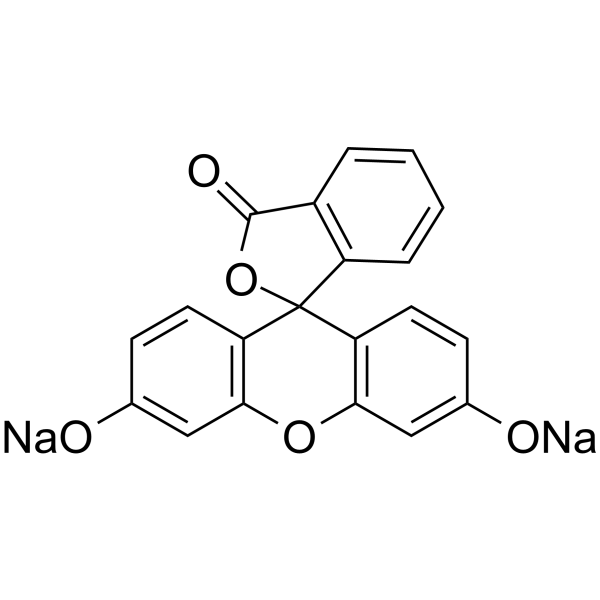Fluorescein sodium

Fluorescein sodium structure
|
Common Name | Fluorescein sodium | ||
|---|---|---|---|---|
| CAS Number | 518-47-8 | Molecular Weight | 376.270 | |
| Density | 1.601 g/cm3 (20ºC) | Boiling Point | 620.8ºC at 760 mmHg | |
| Molecular Formula | C20H10Na2O5 | Melting Point | 320 °C | |
| MSDS | USA | Flash Point | 232.6ºC | |
|
Antioxidant activity of protocatechuates evaluated by DPPH, ORAC, and CAT methods.
Food Chem. 194 , 749-57, (2015) Hibiscus sabdariffa L. is a worldwide consumed plant, principally after infusion of its dried sepals and calyces, which are usually discarded. Nevertheless, they represent a potential source of natural bioactive compounds, e.g. polyphenols, which could add va... |
|
|
Transparent intracortical microprobe array for simultaneous spatiotemporal optical stimulation and multichannel electrical recording.
Nature Methods 12 , 1157-62, (2015) Optogenetics, the selective excitation or inhibition of neural circuits by light, has become a transformative approach for dissecting functional brain microcircuits, particularly in in vivo rodent models, owing to the expanding libraries of opsins and promote... |
|
|
Brain Invasion by Mouse Hepatitis Virus Depends on Impairment of Tight Junctions and Beta Interferon Production in Brain Microvascular Endothelial Cells.
J. Virol. 89 , 9896-908, (2015) Coronaviruses (CoVs) have shown neuroinvasive properties in humans and animals secondary to replication in peripheral organs, but the mechanism of neuroinvasion is unknown. The major aim of our work was to evaluate the ability of CoVs to enter the central ner... |
|
|
Effect of 0.025% FK-506 eyedrops on botulinum toxin B-induced mouse dry eye.
Invest. Ophthalmol. Vis. Sci. 56(1) , 45-53, (2015) To investigate the effect of FK-506 eye drops on Botulinum toxin B (BTX-B)-induced mouse dry eye.Forty-five CBA/J mice were followed up for 4 weeks after treatment with 0.025% FK-506, vehicle or 0.9% saline eye drops 3 days after intralacrimal glands injectio... |
|
|
Age- and location-related changes in microglial function.
Neurobiol. Aging 36 , 2153-63, (2015) Inflammation in the central nervous system (CNS) is primarily regulated by microglia. No longer considered a homogenous population, microglia display a high degree of heterogeneity, immunological diversity and regional variability in function. Given their low... |
|
|
Permeation enhancement via thiolation: in vitro and ex vivo evaluation of hyaluronic acid-cysteine ethyl ester.
J. Pharm. Sci. 104 , 2153-60, (2015) It was the aim of this study to evaluate the permeation-enhancing effect of synthesized thiolated hyaluronic acid (HA). HA, a naturally found polysaccharide, was chemically modified with l-cysteine ethyl ether (C) via amide bond formation. In vitro permeation... |
|
|
Gold Nanorods Indirectly Promote Migration of Metastatic Human Breast Cancer Cells in Three-Dimensional Cultures.
ACS Nano 9 , 6801-16, (2015) Gold nanomaterials are intensively studied for applications in disease detection, diagnosis and therapeutics, and this has motivated considerable research to determine their interaction with biomolecules, cells and cell behaviors. However, few studies look at... |
|
|
Plant regeneration and biochemical accumulation of hydroxybenzoic and hydroxycinnamic acid derivatives in Hypoxis hemerocallidea organ and callus cultures.
Plant Sci. 227 , 157-64, (2014) Micropropagation of Hypoxis hemerocallidea Fisch. and C.A. Mey was used as a model system to study the influence of cytokinins (CKs) on plant regeneration and biochemical accumulation of hydroxybenzoic and hydroxycinnamic acid derivatives in organ and callus ... |
|
|
Identification of phenolic compounds in petals of nasturtium flowers (Tropaeolum majus) by high-performance liquid chromatography coupled to mass spectrometry and determination of oxygen radical absorbance capacity (ORAC).
J. Agric. Food Chem. 63(6) , 1803-11, (2015) The contents and profile of polyphenols were analyzed in edible petals of nasturtium flowers (Tropaeolum majus) of three colors, and their oxygen radical absorbance capacities (ORAC) were compared. Three primary anthocyanins (ACNs) and 15 non-ACN phenolic com... |
|
|
Effects of quaternization on the morphological stability and antibacterial activity of electrospun poly(DMAEMA-co-AMA) nanofibers.
Colloids Surf. B Biointerfaces 133 , 148-55, (2015) Electrospun nanofibers with antibacterial activity are greatly promising for medical treatment and water purification. Herein we report antibacterial nanofibers electrospun from a series of poly(dimethylamino ethyl methacrylate-co-alkyl methacrylates) (poly(D... |